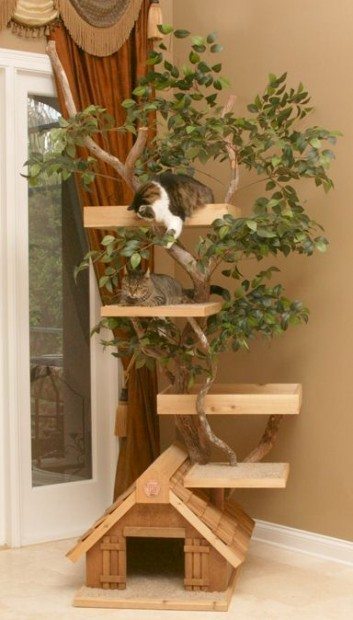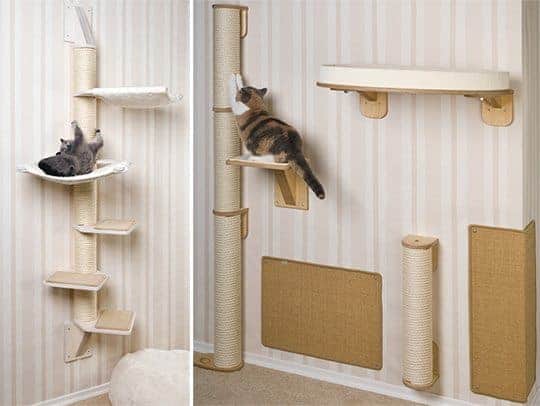How to Build a Cat Tree and Scratching Post
Building your own unique cat tree can help save your furniture and provide your cat with some great vantage points. These structures are quite expensive to buy, but easy to make with a few basic tools.
There are many wonderful cat tree designs available and there really are no limits if you use your imagination. They can be made incredibly cheaply using reclaimed furniture, recycled items or wood off-cuts. You an even use a tree branch if you like the natural look.
Your cat, particularly if he is entirely indoors needs somewhere to scratch and climb so he can express his normal behaviors. Cat trees are a wonderful way of providing a nice high perch, and if you make your own, not only will you save money, but you will be able to make one that fits into your decor and floor-space.
The first step is to get a basic idea of what you want and what you have the tools and capabilities to build. Visit this site for some great basic instructions using basic tools, you can then adapt this plan to your own design.
Components of a Cat Tree
Cat trees can be made from natural tree branches, thick wood posts, PVC pipes and thick cardboard tubes (such as found in the centre of carpet rolls or paper rolls. The basic components are a thick and sturdy base, with a post of some kind made of natural wood, or wood/carcboard covered in carpet off-cuts or sissal rope. You can either drill the post in place, or use brackets if the post is hollow.
Your cat will enjoy multiple levels, perhaps one enclosed like a little cubby-house and one platform, and some dangling toys to play with. It must be sturdy enough that your cat can climb it without it swaying, otherwise your cat will be smart enough to stay away.
While in the planning stage, also consider how you will keep the tree clean, you can vacuum carpeted surfaces, but try to avoid other porous materials that will be difficult to clean. Any cushions or beds should be removable for weekly washing on a hot washing cycle and perhaps attached via Velcro tabs to stop them slipping.
Finally, avoid painting the tree (unless you use natural paints) or using smelly adhesives that might upset your cat’s delicate sense of smell.
What Does Your Cat Like?
Before you start, have a think about what your cat likes to scratch on. A cat that likes to scratch on door-frames, might be better off with a post made of natural wood, or perhaps sissal rope, which is quite rough. If you plan on using sissal, it can take a fair bit of time to wind around a long post and can be comparatively expensive to buy new.
A cat that prefers the leather lounge or carpets, might be better off with post covered in carpet. The added bonus of carpet is that you can change it later when it gets too shredded or you want a different look, and it is easy to staple in place. Just avoid carpet that has loops for your cat to get his claws stuck in.
Cats love hiding places, but also vantage points, so consider using height and multiple levels. If your cat can use the cat tree to look out a window, or escape the dog or children, all the better
Where to Find Materials
Check your council website for recycling centers that may have very cheap materials. In most cities, for example, recycling facilities have everything you need to make a cheap and unique piece of cat furniture such as carpet off-cuts, cardboard tubes, pieces of wood and various other pieces.
You can also check online for more places with recycling options for materials, for example, freecycle. The base is probably the most important part to get right. It needs to be thick and heavy to stabilize the poles coming up from it.
Tools You Might Need
- Staple gun or hot glue gun
- Hammer and nails or drill
- Rivet gun (if you are using PVC piping or a hollow tube for the ‘tree’
- Utility knife to cut carpet
- Saw to cut wood
- Sandpaper
- Nails or Screws
Basic Scratching Post
If you just need a scratching post, make sure it is tall enough that your cat can fully stretch out. Most are much too short. Measure from nose to tip of the tail and make it at least that length. If your cat is scratching on horizontal surfaces, make a horizontal scratching post, it will make it much easier to redirect your pet to the appropriate place.
Tree Branches

Like this stunning structure made from timber and tree branches you can use a large fallen tree branch for this project. Just make sure there are no pests in the wood. The last thing you need are some crawling hitch-hikers and perhaps that tree branch fell for a reason! Martha Stewart has a very stylish example of this too.
Permanent Post
Rather than make a tree, you can make use of existing furniture and structures within your house. A length of carpet or rope covered board can be fixed to a wall, or to the side of a bookcase. Shelves and platforms can be screwed securely directly into the walls to create a series of platforms.
If you already have tall bookshelves, consider fixing them to the wall to make them stable and secure (think baby-proofing for climbing toddlers), then attach some extra shelves on the outside to allow your cat to access the top. This top shelf is ideal as a cat vantage point, and is often unused space.

Cat Tree or Condo
One way of building a condo is to use a cardboard cylinder with openings. There are some great plans available online. You can do a similar design with boxes, or even just stack some sturdy cardboard boxes on top of each other. Those thick boxes from the fruit shop would be excellent for making a temporary cat tree, just stack them and cut some holes out to create some nice cubby-holes.
Building a Cat Tree From Found Items
This beautiful cat tree has been made out of an old bookshelf. An old chest of drawers, ladder or parts of a chair could also be reclaimed to make a fabulous tree. Here’s some more inspiration on cat trees, condos and amazing cat homes.
How to Get Your Cat to Scratch on the Post
If your cat doesn’t quite understand how amazing his new post is, show him how to scratch it by making noisy scratches yourself while he watches. You need to make it as attractive as possible, and the place he was using as unattractive as possible.
Some cats are scratching to release pheromones, so if your cat is determined to scratch elsewhere, first try spraying the place he is scratching with Feliway daily, or place aFeliway diffuser nearby. You can also use Feliway to spray the scratching post to hopefully mask any weird smells that may be off-putting for your cat. Cover the area he was scratching until you have him retrained, or restrict his access.
If it is a door frame, stick some tin foil over the spot to deter him, while you encourage him to use the new post. The foil trick can also work with the couch or rugs.
Each time you see him attempting to scratch in the wrong place, redirect him to the new place. You may need to initially start with the post near his old scratching spot. Alternatively, near his sleeping area as cats love to stretch and scratch when they wake up. It can then be moved gradually to a more appropriate place once he has the habit of using it.
Avoid punishment to stop him scratching, it just teaches him not to do it while you are around and doesn’t give him an alternate behaviour. Also keep treats (if your cat is fussy try fishy pastes, like anchovette, pate or vegemite) nearby so you can reward him if he does use the new post.
Good luck!
The post How to Build a Cat Tree and Scratching Post appeared first on VetBabble.




Post a Comment